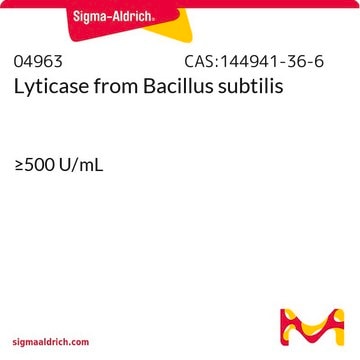L2524
Lyticase from Arthrobacter luteus
lyophilized powder, ≥2,000 units/mg protein, Protein ≥20 % by biuret
Synonim(y):
(1,3)-β-D-Glucan endohydrolase, 1,3-β-Glucan glucohydrolase, Bacterial lyticase, Lysing enzyme
About This Item
Polecane produkty
pochodzenie biologiczne
bacterial (Arthrobacter luteus)
Poziom jakości
Postać
lyophilized powder
aktywność właściwa
≥2,000 units/mg protein
skład
Protein, ≥20% biuret
metody
cell based assay: suitable
przydatność
suitable for cell lysis
Zastosowanie
diagnostic assay manufacturing
temp. przechowywania
−20°C
Szukasz podobnych produktów? Odwiedź Przewodnik dotyczący porównywania produktów
Zastosowanie
- for spheroplasting the cells
- as a component of digestion solution to incubate yeast cells for digestion of the cell wall
- in the enzymatic hydrolysis of the mycelium precipitate to prepare protoplasts
Działania biochem./fizjol.
Definicja jednostki
Postać fizyczna
Inne uwagi
Hasło ostrzegawcze
Danger
Zwroty wskazujące rodzaj zagrożenia
Zwroty wskazujące środki ostrożności
Klasyfikacja zagrożeń
Resp. Sens. 1
Kod klasy składowania
11 - Combustible Solids
Klasa zagrożenia wodnego (WGK)
WGK 3
Temperatura zapłonu (°F)
Not applicable
Temperatura zapłonu (°C)
Not applicable
Środki ochrony indywidualnej
Eyeshields, Gloves, type N95 (US)
Certyfikaty analizy (CoA)
Poszukaj Certyfikaty analizy (CoA), wpisując numer partii/serii produktów. Numery serii i partii można znaleźć na etykiecie produktu po słowach „seria” lub „partia”.
Masz już ten produkt?
Dokumenty związane z niedawno zakupionymi produktami zostały zamieszczone w Bibliotece dokumentów.
Klienci oglądali również te produkty
Protokoły
This procedure may be used for the determination of Lyticase activity using Baker’s yeast as the substrate.
Procedura ta może być stosowana do oznaczania aktywności litykazy przy użyciu drożdży Bakera jako substratu.
Nasz zespół naukowców ma doświadczenie we wszystkich obszarach badań, w tym w naukach przyrodniczych, materiałoznawstwie, syntezie chemicznej, chromatografii, analityce i wielu innych dziedzinach.
Skontaktuj się z zespołem ds. pomocy technicznej








